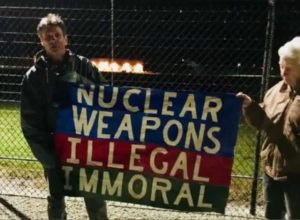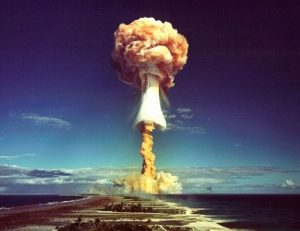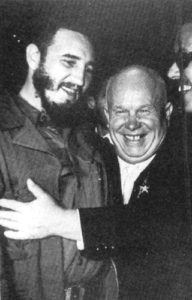Podcast: Play in new window | Download
Lawyers Committee on Nuclear Policy
The United States of America was the first, and has since been the only, country to use nuclear weapons. In 1945, at the end of World War II, the US bombed Hiroshima and days later bombed Nagasaki, exterminating several hundred thousand people. The bomb was used twice to intimidate the Russians even as the United States knew that Japan wanted peace.
The United States has embarked on a one and a half trillion-dollar project to upgrade its nuclear arsenal. It has developed the capacity to fire these weapons so that they are delivered across oceans in a matter of minutes with all of the frightening implications. The prestigious Bulletin of Atomic Scientists has a “Doomsday Clock.” The minute hand on the clock has been steadily advancing and is now only 100 seconds to midnight.
Because of their devastating civilian killing capacity, the use of or threat to use these weapons is unlawful.
Unlike the Paris climate agreement, which set goals for the reduction of fossil fuels, there are no targets for the express reduction of nuclear weapons. Nor have countries’ efforts to reach such targets been assessed. We have no global process for the elimination of nuclear weapons.
Guest – Attorney John Burroughs, is the former Executive Director, now Senior Analyst, of the Lawyers Committee on Nuclear Policy. LCNP was founded in 1981 as an association of lawyers and legal scholars who engage in research and advocacy in support of the elimination of nuclear weapons. The Lawyers Committee on Nuclear Policy serves as the United Nations office of the International Association of Lawyers against Nuclear Arms. John has represented LCNP in Nuclear Non-Proliferation Treaty review proceedings and in negotiations on the Treaty to Prohibit Nuclear Weapons.
—-
Ukraine Crisis and Parallels To The Cuban Missile Crisis
As tensions between Russia, Ukraine, the United States and other NATO countries escalate, the corporate media is portraying the conflict as aggression by Russia and US-NATO’s position as purely defensive. But even though the Biden administration is rattling its economic, political and military sabers at Russia, Ukrainian President Zelensky says a Russian invasion of Ukraine is not imminent and warns that “panic” by U.S. and other NATO leaders is causing economic destabilization in Ukraine. Meanwhile, the U.S. is sending massive amounts of weapons to Ukraine, boosting the profits of military contractors.
In 1990, as the Soviet Union was disbanding, then US Secretary of State James Baker assured the Soviets that NATO would not expand “one inch to the East.” Nevertheless, since the late 1990s, NATO has expanded to include many countries including some that border Russia, which Russia sees as a real threat. If Ukraine joins NATO, Russia considers that an “existential threat.”
Since the US-supported 2014 coup in Ukraine that led to the ouster of President Viktor Yanukovich, the US has delivered $2 billion in military aid to Ukraine.
Although Ukraine and Russian-backed separatists signed a 12-point ceasefire deal in 2014, known as the Minsk agreements, Ukraine has not implemented the constitutional changes required by the Minsk agreements. The unconditional US military assistance to Ukraine has encouraged the Ukrainian government to ignore the Minsk agreements and reassert sovereignty over Russian Crimea.
In October, Ukraine launched attacks in Donbass, Russia, and Russia responded with troop movements and military exercises. The US is framing Russia’s troop movements as a threat to invade Ukraine without provocation.
Professor H. Bruce Franklin, author of the 2018 book, Crash Course: From the Good War to the Forever War, has drawn parallels between today’s standoff at Ukraine’s border and the Cuban missile crisis, although the great power roles were reversed.
Guest – Bruce Franklin is a former Air Force navigator and intelligence officer, a progressive activist, and the John Cotton Dana Professor of English and American Studies, emeritus at Rutgers University in Newark, New Jersey. He has authored or edited 19 books and has received lifetime achievement awards from the American Studies Association and other major academic organizations.
—————————————




